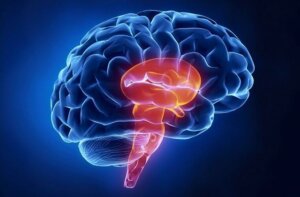The Human Brainstem: The Butterfly in the Brain

The brainstem is a tubular structure found in the most posterior part of the human brain. It’s attached to the spinal cord. The human brainstem is very important to our survival. It regulates many of our autonomic and semi-autonomic basic functions, including our heart rate and breathing. Any damage to this part of the brain could be fatal.
The brainstem is a critical part of the human body. In fact, it’s split into different areas that each have a specific function. Looking at the human brainstem horizontally, it seems to be shaped like a butterfly. The 2007 French film The Diving Bell and the Butterfly tells the story of a man who suffers brain damage and is left with locked-in syndrome, as many of his cerebral functions are damaged. This film shows the importance of the human brainstem, which this article will explore in more detail.
The human brainstem
Although the brainstem can just seem to be a bridge between the spinal cord and the rest of the nervous system, it’s much more than that. Dozens of nerve fibers pass through the spinal cord and are connected to the brainstem.
This structure comprises both gray and white matter. Almost all of the cranial nerves, which receive the nerve messages sent through the spinal cord, emerge from the brainstem,
Within the human brainstem, there are several areas of gray matter. The best-known area is the red nucleus of the midbrain. Other outer parts of the brainstem contain white matter.
In addition to the separate areas of gray and white matter, there’s another area of the brainstem where the two matters mix. This is the reticular formation. In other words, the brainstem contains both control neurons and important connections to the rest of the body. In fact, it comprises three separate areas or substructures: the midbrain, the pons, and the medulla oblongata.
Parts of the brainstem
The human brainstem comprises three main structures:
- Midbrain. The midbrain is the upper part of the brainstem, close to the thalamus. In turn, the midbrain comprises three structures. The most important are the tectum (the dorsal side) and the tegmentum (the ventral side). Another important structure is the cerebral aqueduct, which contains the cerebrospinal fluid, a substance that’s equally important to the brain’s functions. The midbrain controls certain movements, reflex reactions to visual and aural stimuli, the regulation of body temperature, and sleep-wake cycles.
- Pons. Also sometimes called the pons Varolii, this structure is the largest part of the human brainstem. It’s located in the center of the structure, between the midbrain and the medulla oblongata. Its main function is to connect two other structures, so any damage to the pons can affect the functions of both the midbrain and the medulla oblongata. The cerebellum is located on the upper side of the pons, which contains the basilar artery. In addition to being an important neurological center for the functions of the midbrain and the medulla oblongata, the pons itself plays an important role in vital functions like the regulation of breathing and consciousness.
- Medulla oblongata. This is the lowest part of the brainstem, which communicates directly with the spinal cord. The medulla oblongata contains important substructures called medullary pyramids, which, in turn, contain motor fibers that pass from the brainstem to the spinal cord. It controls vital autonomic processes such as the heartbeat and secretion of gastric substances.
Other functions of the human brainstem
In addition to crucial functions such as consciousness, breathing, heartbeat, and the secretion of gastric substances, the brainstem also plays a role in other important functions. These are vital functions that keep us alive, such as the regulation of body temperature, swallowing, vomiting, coughing, and our sensitivity to pain.
The human brainstem is also the most important channel of communication between the body and the brain, making it fundamental to our survival. This communication is made through both afferent fibers (body-brain) and efferent fibers (brain-body).
The brainstem can be compared to a very sophisticated piece of engineering. It’s so sophisticated that any imbalance in the brainstem can have devastating effects on the rest of the body. It’s important to remember that the brainstem controls many of our most vital functions. You could even say that it contains a beautiful butterfly full of life.
This text is provided for informational purposes only and does not replace consultation with a professional. If in doubt, consult your specialist.








